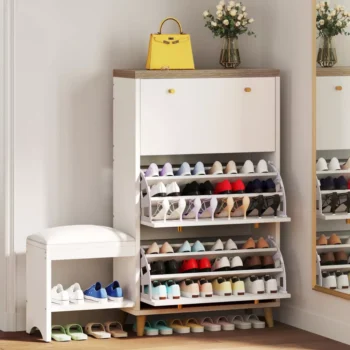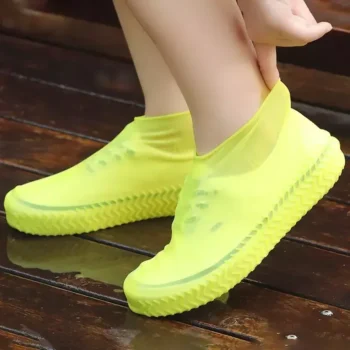Eco-Friendly Shoe Cabinets: Sustainable Storage Options
As environmental awareness grows, more people are seeking ways to make their homes more sustainable. One area often overlooked is shoe storage. Eco-friendly shoe cabinets not only help organize your footwear but also reduce your carbon footprint.
In this guide, we’ll explore various sustainable storage options for your shoes and how they can contribute to a greener home.
1. Why Choose Eco-Friendly Shoe Cabinets?
Choosing eco-friendly shoe cabinets is beneficial for several reasons:
- Environmental Impact: Traditional furniture production often involves deforestation, pollution, and significant energy consumption. Eco-friendly options typically use sustainable materials and practices that reduce these impacts.
- Health Benefits: Eco-friendly materials are often free from harmful chemicals found in conventional furniture, promoting a healthier indoor environment.
- Durability: Sustainable materials tend to be durable, meaning your furniture lasts longer and reduces waste over time.
- Aesthetic Appeal: Eco-friendly designs often have a natural and unique aesthetic that can enhance your home’s decor.
2. Sustainable Materials for Shoe Cabinets
When selecting an eco-friendly shoe cabinet, consider these sustainable materials:
- Bamboo: Bamboo is a fast-growing, renewable resource. It’s strong, durable, and has a stylish, natural look. Bamboo shoe cabinets are lightweight yet sturdy, making them a popular eco-friendly choice.
- Reclaimed Wood: Using reclaimed wood reduces the demand for new timber and minimizes waste. Each piece of reclaimed wood furniture has a unique history and character, adding a rustic charm to your home.
- Recycled Plastic: Some shoe cabinets are made from recycled plastic, which helps reduce landfill waste. These cabinets are durable, lightweight, and easy to clean.
- Sustainable Wood: Look for certifications like FSC (Forest Stewardship Council) to ensure the wood comes from responsibly managed forests. Sustainable wood options include oak, maple, and teak.
- Natural Fiber: Cabinets made from natural fibers like jute, rattan, or seagrass are biodegradable and add a touch of nature to your space.
3. Eco-Friendly Shoe Cabinet Designs
There are various eco-friendly designs to suit different tastes and needs:
- Minimalist Designs: Simple, clean lines reduce material usage and waste. Minimalist designs often incorporate multi-functional features, maximizing utility while minimizing environmental impact.
- Modular Systems: Modular shoe cabinets can be customized to fit your space and storage needs. They are often made from sustainable materials and can be easily reconfigured, extending their usability.
- Vintage and Upcycled Furniture: Repurposing old furniture into shoe cabinets is a creative and eco-friendly option. Look for vintage pieces at thrift stores or online marketplaces, and give them a new life with a bit of refurbishment.
4. Tips for Creating an Eco-Friendly Shoe Storage System
To maximize the sustainability of your shoe storage, consider these tips:
- DIY Projects: Building your own shoe cabinet from sustainable materials can be rewarding and eco-friendly. Use reclaimed wood or bamboo and avoid toxic paints and finishes.
- Repurpose Existing Furniture: Convert an old bookshelf, dresser, or crate into a shoe cabinet. This reduces waste and gives new purpose to items you already own.
- Buy Secondhand: Purchasing secondhand furniture reduces demand for new products and extends the life of existing items. Look for quality pieces that can be easily refurbished if needed.
- Choose Quality Over Quantity: Invest in a high-quality, durable shoe cabinet that will last for years. This reduces the need for frequent replacements and minimizes waste.
5. Maintaining Your Eco-Friendly Shoe Cabinet
Proper maintenance extends the life of your shoe cabinet and keeps it looking great:
- Regular Cleaning: Dust and clean your cabinet regularly using eco-friendly cleaning products. Avoid harsh chemicals that can damage the materials and harm the environment.
- Protect from Moisture: Keep your shoe cabinet in a dry area to prevent mold and mildew. Use dehumidifiers or moisture-absorbing products if necessary.
- Repair, Don’t Replace: If your cabinet gets damaged, try to repair it instead of replacing it. Small scratches can be sanded and refinished, and loose joints can be tightened.
6. The Broader Impact of Eco-Friendly Choices
Choosing eco-friendly shoe cabinets is part of a larger movement towards sustainable living. Each eco-friendly choice you make contributes to:
- Reduced Deforestation: By opting for sustainable materials, you help reduce the demand for wood from endangered forests.
- Lower Carbon Footprint: Sustainable materials and manufacturing processes typically produce fewer carbon emissions.
- Waste Reduction: Durable, long-lasting furniture reduces the amount of waste that ends up in landfills.
- Support for Ethical Companies: Purchasing from companies committed to sustainability encourages more businesses to adopt eco-friendly practices.
Conclusion
Eco-friendly shoe cabinets offer a stylish and sustainable way to organize your footwear. By choosing cabinets made from sustainable materials, adopting eco-friendly designs, and maintaining your furniture properly, you can significantly reduce your environmental impact. Embrace the trend of sustainable living and make your home both beautiful and green with eco-friendly shoe storage solutions.





